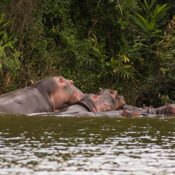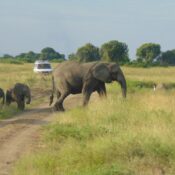
Amboseli National Park
Amboseli National Park
Overview
Amboseli National Park, located in Kajiado County, is one of Kenya’s most renowned wildlife reserves near the border with Tanzania, covering 392 km². Originally a Maasai game reserve in 1948, the Maasai were permitted to graze in certain areas, and it was later designated as a national park in 1974 to preserve its unique ecosystem. Recognized as a UNESCO World Biosphere Reserve in 1991 for its global ecological importance, the park’s history is deeply connected to efforts in conservation and Maasai traditions. The name Amboseli derives from the word Empusel, meaning ‘salty dusty place’ in Maasai. The park is famous for its expansive open plains, interspersed with woodlands, swamps, seasonal lakes, abundant wildlife, and breathtaking views of Mount Kilimanjaro, making it one of Kenya’s most popular parks.
Amboseli National Park's vegetation is sustained by water from Mount Kilimanjaro’s glaciers, which emerge from springs and swamps, providing water even during dry seasons. This makes the park a vital refuge for wildlife year-round. The park’s main vegetation includes open grasslands, savannahs, acacia woodlands, swamps, marshes, magma springs, and seasonal lake beds. Amboseli is home to a variety of wildlife, with a famously large elephant population that attracts scientific research. Besides elephants, the park hosts mammals like buffalo, giraffes, wildebeests, zebras, lions, cheetahs, gazelles, hyenas, jackals, waterbucks, crocodiles, snakes, frogs, hares, warthogs, yellow baboons, vervet monkeys, and many more. Over 450 bird species inhabit the park, including African jacana, black-winged stilt, African spoonbill, yellow-billed stork, great egret, spur-winged goose, lesser and greater flamingos, martial eagle, tawny eagle, African fish eagle, secretary bird, kori bustard, lilac-breasted roller, ostrich, malachite kingfisher, papyrus gonolek, northern wheatear, barn swallow, herons, and ibises. The combination of open savannah, wetlands, and seasonal lakes provides ample habitats for all the park’s wildlife and birds.
Attractions in Amboseli
Wildlife
Over 80 mammals, including 4 of the big five, call Amboseli National Park home. The park is also home to the largest herds of elephants, however it is home to other mammals too like lions, leopards, buffalo, cheetahs, zebras, giraffes, zebras, hippos, wildebeest, dik-diks, hyraxes, gazelles, mongooses, porcupines, hyenas, jackals, aardwolf, baboons, vervet monkeys, duikers, waterbucks, gerenuk, topis, crocodiles, kudu, African wild dogs, and many more can easily be seen enjoying free movement in Amboseli.
Birds
Amboseli National Park is home to over 450 bird species, with about 47 raptor species, making the park a birder’s haven. The park has resident and migratory birds that include yellow-necked spurfowl, grey-crowned crane, dusky turtle dove, red-eyed dove, secretary birds, long-toed lapwing, rufous-bellied heron, spike-heeled lark, lesser and greater flamingos, white-bellied go away bird, pangani, African jacana, black-winged stilt, African spoonbill, yellow-billed stork, martial eagle, tawny eagle, African fish eagle, lilac-breasted roller, ostrich, malachite kingfisher, papyrus gonolek, northern wheatear, barn swallow, superb starling, hammerkop, egrets, and many more.
Observation hill
The Observation Hill is a small hill near the center of Amboseli National Park that offers a panoramic view to the visitors. Being the only spot where visitors can walk, from the top, they get a full view of various sights, including elephants moving below, the swamps, and Kilimanjaro in the background. The permanent swamps below the hill ensure large numbers of elephants, buffalo, hippos, and water birds as they provide water for the wildlife. The Hill is not only an observation point, however doubles as a perfect spot for picture taking and serene moments to appreciate the park’s beauty.
Landscapes
In Amboseli National Park, the landscapes are another attraction as they define the park’s scenery with its remarkably varied contrast between the dry plains and lush wetlands. The park’s open savannah plains, swamps, marshes, seasonal Lake Amboseli, acacia woodlands, and the backdrop of Mount Kilimanjaro are some of the key landscapes that not only create the beautiful scenery but also sustain the variety of wildlife, making Amboseli an ecological treasure.
Community
Amboseli is mainly surrounded by the Maasai people, a community that is an attraction in its own right. The Maasai have a distinctive culture, with a traditional pastoral lifestyle that complements the park experience by providing intimate interactions with tourists. This offers a deeper understanding of the region's human heritage. Visitors will have the chance to learn about Maasai culture firsthand through music, dance, drama, storytelling, arts and crafts, and homesteads. These engagements give visitors an authentic cultural experience that enhances their overall visit to the park.
Activities
Game drives in Amboseli
Game viewing is one of the most popular activities in Amboseli National Park, allowing visitors to experience its rich biodiversity through the open savannahs, swamps, and dry plains. The game drives can be conducted either in the morning or late afternoon, during which wildlife such as elephants, lions, leopards, giraffes, zebras, buffalo, hyenas, cheetahs, Grant’s gazelles, wildebeests, and many more can be seen. Additionally, birds like the African fish eagle, martial eagle, secretary bird, flamingos, pelicans, helmeted guineafowl, superb starlings, bee-eaters, African jacanas, and others are often spotted. This is made possible with the help of experienced guides who assist in tracking animals and birds and share valuable information about the park.
Bird watching
Bird watching is another incredible activity that attracts both casual and serious birders, as the park is home to over 400 bird species. Amboseli National Park has diverse habitats including open plains, acacia woodlands, wetlands, and swamps, which host birds like greater and lesser flamingos, grey crowned cranes, African jacanas, pelicans, martial eagles, bateleur eagles, secretary birds, ostriches, helmeted guineafowls, great egrets, black-headed herons, saddle-billed storks, superb starlings, African pygmy falcons, African fish eagles, yellow-billed storks, kingfishers, and many more. With the help of an experienced guide, bird watching occurs throughout the year, including migratory birds on the list, enabling visitors to spot a wide variety of colorful and rare bird species within the park.
Observation Hill
The Observation Hill is one of the highlights of Amboseli National Park, offering a panoramic view of the surrounding landscapes. On top, visitors can enjoy the views of the open plains, swamps, wildlife, and on clear days, the dramatic backdrop of Mount Kilimanjaro, making for a perfect picture-taking spot. With proper trails designated, hiking to the top of the hill is easy and once there, visitors can spot elephants, buffaloes, zebras, wildebeests, giraffes, impalas, hippos, hyenas, and many more with birds like martial eagles, bateleur, augur buzzard, Egyptian geese, pangani longclaw, ostriches, bee-eaters, herons, egrets, flamingos, and many more paired well with the beautiful scenery.
Guided nature walks
Guided nature walks as an activity are a more personal and intimate way to experience Amboseli National Park. Different from game drives, nature walks allow visitors to traverse the park on foot in zones designated for the exact purpose, led by experienced guides and armed rangers. The inner details of the park’s ecosystem, which includes the plants, trees, animals, birds, insects, and vegetation, can all be studied. During the guided nature walks, visitors can spot birds and wildlife like elephants, lions, buffaloes, giraffes, zebras, gazelles, hyenas, wildebeests, common dwarf mongoose, flamingos, pelicans, egrets, herons, martial eagles, African fish eagles, pangani longclaw, African jacana, steel-blue whydah, hornbills, and many more. The walks are best done in the early morning or late afternoon, which ensures a peaceful way for visitors to connect with nature in the park.
Community tours
Community tours give visitors a chance to experience the rich culture of the Maasai people who live around Amboseli National Park. These tours are arranged by local guides to help provide insight into the traditional customs, practices, and lifestyles of the Maasai villages that have been protected for a long time. During the tours, visitors can engage in dance, drama, music, storytelling, arts and crafts, herding practices, and see how Maasai manyattas are built. With guides offering information on how the Maasai people coexist with the wildlife surrounding them, and conservation efforts that protect the park as a natural environment. The tours also support local livelihoods, as part of the fees go directly to the community.
Amboseli National Park is 240km southeast of Nairobi and can be reached both by road and air. By road, the drive will take about 4-5 hours, depending on the road conditions and traffic, giving visitors access through the Kimana or Meshanani gates to the park. And by air, the flight will take about 45 minutes from Nairobi to Amboseli National Park. Amboseli National Park can be visited year-round, depending on what the visitors want to experience; however, the best time is during the dry seasons of June to October and January to February which is ideal for game viewing, as the roads are easier to navigate.
All Categories
Recent Posts
admin0 Comments
Amboseli National Park
admin0 Comments
Boat Cruise in Lake Mburo National Park
admin0 Comments



